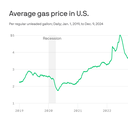Starbucks union plans five-day strike starting Friday
The union that represents more than 11,000 Starbucks workers said it plans on launching a five-day strike beginning Friday morning.
Why it matters: The holiday season is one of the company's busiest times of year, and the stoppages will hit three big markets — Los Angeles, Chicago and Seattle.
- Their planned strike follows a work stoppage launched by Amazon warehouse workers Thursday morning.
State of play: The union said Thursday night the walkouts will continue across the country, ultimately reaching "hundreds of stores from coast to coast by Christmas Eve."
- More than 500 Starbucks stores are now unionized — a relatively small fraction of the company's approximately 10,000 U.S. stores.
The big picture: Neither the Starbucks nor Amazon unions have reached a first contract, years after unionizing.
- But contracts are why unions organize. It's where employers and workers hammer out deals on pay and benefits.
- Unlike in Amazon's case where the company hasn't yet come to the negotiating table, Starbucks union members have been bargaining with the coffee giant all year.
The union may feel some urgency to make progress before President-elect Trump takes office next year and appoints a Republican majority to the National Labor Relations Board, which is expected to be less friendly to workers, says John Logan, a labor historian at San Francisco State University.
- "This might be their last best chance."
Where it stands: The union says the company hasn't offered up a workable proposal. In a release, they say the company hasn't offered any wage increases and "a guarantee of only 1.5% in future years."
- "We were ready to bring the foundational framework home this year, but Starbucks wasn't," says Lynne Fox, President of Workers United.
For the record: In a statement, Starbucks said the union "prematurely ended bargaining this week," adding that they've already reached meaningful agreements on hundreds of topics.
- "We are ready to continue negotiations to reach agreements. We need the union to return to the table."
Editor's Note: This story has been updated to comments from a labor expert.


















